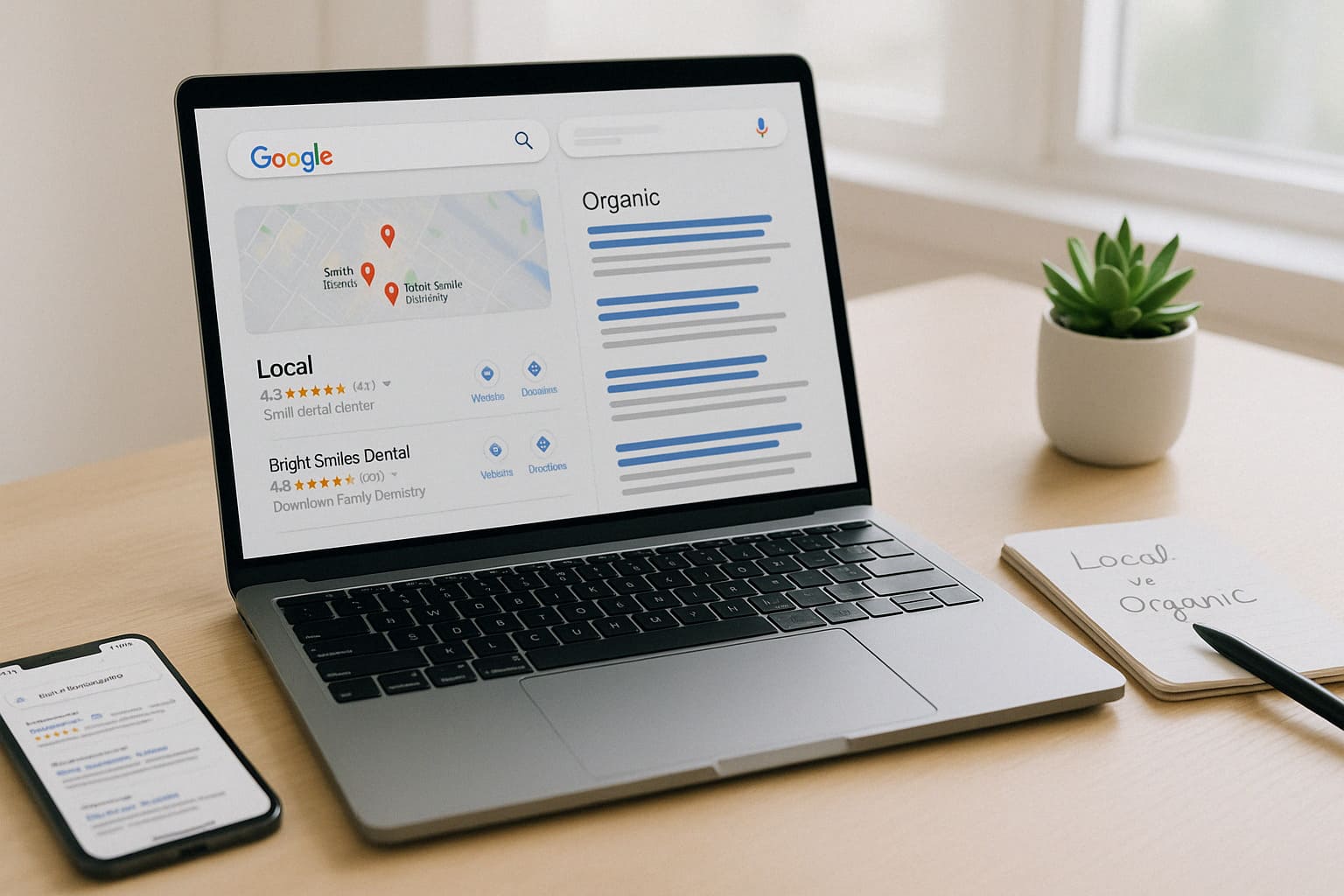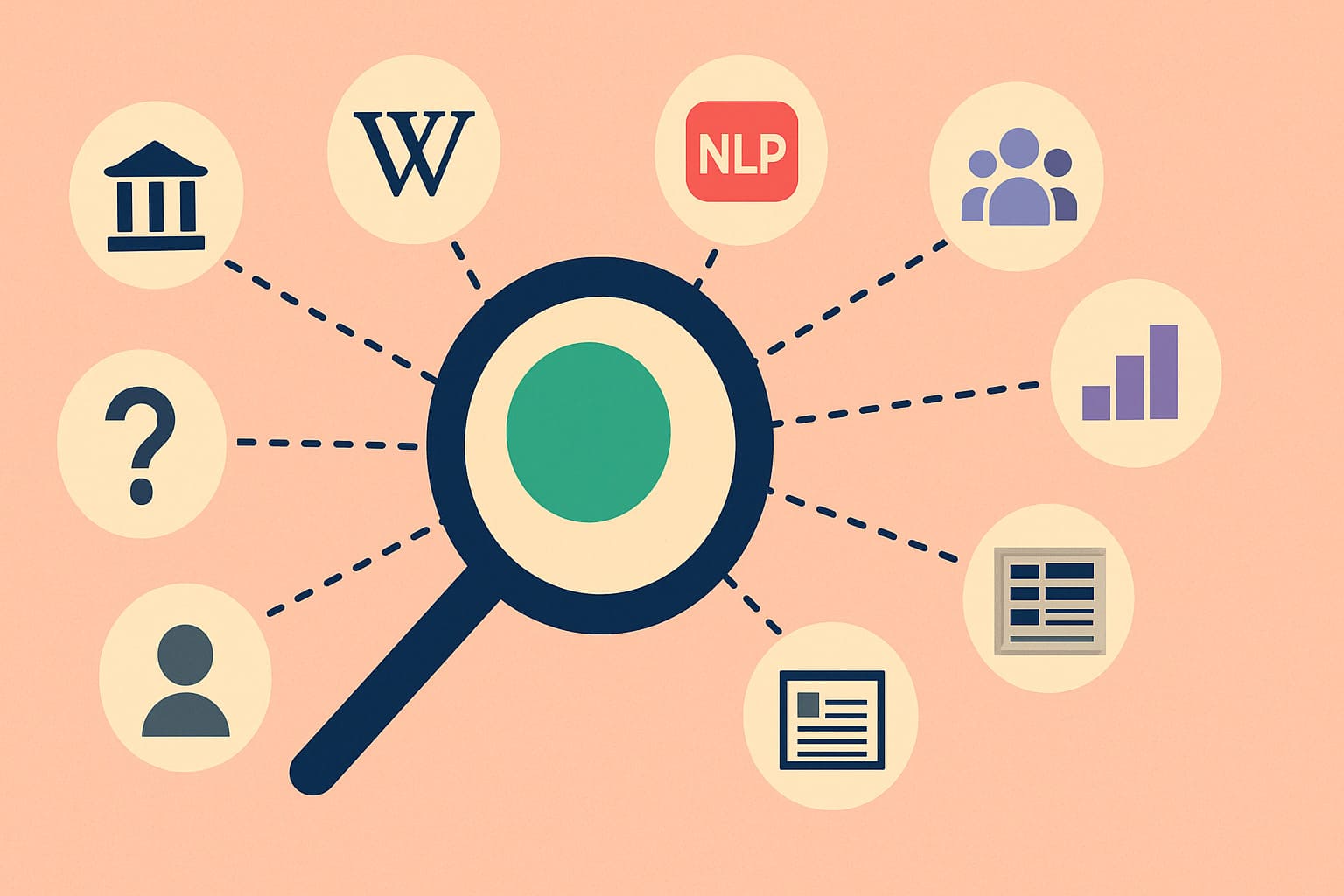You fixed your site. You used keywords. Still, no one nearby calls. Then you search online—and find your competitor listed right on the map. You scroll. They also appear in blue links. You? Nowhere.
That is not random. Google ranks based on signals it trusts. And the reason is simple:
“Local SEO ranks you for where you are. Organic SEO ranks you for what you say.”
This is where most businesses get it wrong. They treat SEO like one big box. But Google splits search results into two very different layers: one for local signals, one for website strength.
Local SEO tells Google where you are, who you serve nearby, and how visible your business is in real-world search zones like the Google Map Pack.
Organic SEO tells Google what you know, how strong your content is, and why your site deserves clicks everywhere else.
If you miss one, you lose half your real traffic. And worse—your competitor locks that space instead.
In this pos. It breaks down the exact difference between local SEO and organic SEO, with real terms like NAP Consistency, Map Pack, Topical Authority, and Schema Markup.
We also explain how to combine both without breaking your site—or confusing Google.
Local SEO vs Organic SEO: The Quick Difference
Before we go deep, let us clear up the confusion fast. Most people think SEO is just one thing. But Google sees local and organic SEO as two separate systems. The table below shows how they differ.
| Factor | Local SEO | Organic SEO |
|---|---|---|
| Focus | Location-based visibility | Content and site authority |
| Main Goal | Show up in Map Pack | Rank in search results |
| Key Tools | Google Business Profile, NAP, Reviews | Keywords, Backlinks, Technical SEO |
| Ideal For | Local shops, service-area businesses | Blogs, eCommerce, national brands |
| Result Format | Map + Business Cards | Blue link listings on search results |
What Is Local SEO?
Local SEO is a type of search engine optimization that helps your business appear in local Google searches. It focuses on showing your business to people who are nearby or searching for services in your area.
If you have a business, clinic, office, or serve customers in a specific city or region, local SEO helps you show up on the map, in the top 3 business listings, and nearby search results.
It uses signals like your business address, contact number, reviews, and Google Business Profile to tell Google you are a trusted local provider.
How Google Understands Local SEO
Google does not just scan your website. It looks for signals that say,
“This business exists here. It serves people nearby. It can be trusted.”
These signals come from:
- Your Google Business Profile
- NAP Consistency (same Name, Address, Phone everywhere)
- Customer Reviews
- Your distance from the searcher (called Proximity to Searcher)
- Mentions of your business on local sites (Local Citations)
- Local backlinks (like news or chamber websites)
- A complete LocalBusiness Schema Markup
When all of these align, your listing earns a spot in the Google Map Pack. That is the top 3 map box you see above normal results.
Who Needs Local SEO?
If people can walk into your store, call your service, or need you to come to them—you need local SEO.
This is not just for restaurants or salons. It is for any business that operates in a fixed area or serves specific cities, towns, or neighborhoods.
“If Google does not know where you are, nearby customers will never find you.”
Here are real examples:
- Dentists, doctors, and clinics
- Restaurants, cafes, and bakeries
- Lawyers and real estate agents
- Salons, spas, and gyms
- Electricians, plumbers, and home services
- Local stores, boutiques, and repair shops
- Schools, coaching centers, and training institutes
Each of these depends on local visibility, not global reach.
They need to show up in the Google Map Pack, have accurate NAP details, and gain trust through reviews and photos.
What Is Organic SEO?
If your goal is to get clicks from people beyond your city or map range, Organic SEO takes over. Organic SEO is a way to improve your website’s ranking in unpaid search results on platforms like Google or Bing.
It involves optimizing your website so that search engines naturally show it higher when people look for relevant information—without paying for each click.
For example, if a financial site writes helpful content on personal loans, and that content is fast, well-structured, and relevant, Google might show it to people searching that term. That traffic is called organic traffic.
How Organic SEO Works
Organic SEO works by helping search engines understand what your website is about and why it deserves to rank higher than others.
Google looks at what you say, how well you say it, and how others react to it.
Here is what makes organic SEO work:
- Keyword Optimization: You use the right search phrases that people type.
- High-Quality Content: Your pages answer real questions clearly and fully.
- Technical SEO: Google can crawl and load your site fast.
- Backlink Profile: Other good websites link to your content.
- On-Page SEO: You use proper headings, internal links, and meta titles.
- User Experience (UX): People stay, scroll, and explore your pages.
- Schema Markup: You use code to help Google read your content better.
- Core Web Vitals: Your site loads fast, does not jump, and works well on phones.
Google sees all this and thinks:
“This page is useful. Let us rank it higher.”
Unlike local SEO, organic SEO is not tied to a location. It works for blogs, eCommerce, services, or anything that serves users across cities or countries.
Who Needs Organic SEO?
If your business is not tied to one street, one city, or one local market—you need organic SEO.
This strategy helps you reach people across regions, devices, and intent types, without relying on maps or physical presence.
“If your audience is searching beyond one location, organic SEO is your growth path.”
Here are the types of businesses that depend on organic SEO:
- eCommerce websites selling products across India or globally
- SaaS platforms offering software tools online
- Bloggers and publishers creating news, guides, or how-to content
- Educational portals reaching students from different locations
- Digital service providers like SEO, design, or consulting
- Health websites sharing wellness, fitness, or treatment content
- Affiliate marketers driving traffic to product links
These businesses grow by showing up for high-intent search terms like “best running shoes under 2000” or “how to reduce electricity bill”.
They win clicks by ranking high in organic results—not through paid ads, and not by showing up on a map.
What Are the Key Differences Between Local and Organic SEO?
Local SEO and Organic SEO both fall under search engine optimization (SEO). Both help your business appear on Google. But they serve different goals and follow different rules.
Local SEO focuses on making your business appear for location-based searches. These include terms like near me, in Noida, or open now. It connects users with businesses that operate in a specific area.
Organic SEO focuses on making your website rank higher in regular search results, without needing location signals. It works best when you want to attract users through content, helpful answers, or product pages—regardless of where they live.
Think of it this way: Local SEO connects you with people nearby. Organic SEO connects you with people searching for what you offer, anywhere.
Where Do Local and Organic SEO Results Show?
Local SEO makes your business listing appear in the Google Map Pack—the 3 boxes that show local businesses with ratings, hours, and location pins. This is where users often click when they want fast, nearby results.
Organic SEO places your website inside the normal blue link results that appear below or beside the maps. This is where most informational or national results show.
For example:
- A plumber in Greater Noida wants to appear in the map when someone types plumber near me
- A fitness blogger wants their article on best home workouts to show up in organic results for users anywhere
Both results are powerful—but they require different strategies to win.
What Signals Matter Most
Google uses different sets of signals to decide where your business or website should rank.
Each type—local SEO or organic SEO—has its own ranking system. That means what helps you show up in the Map Pack is not the same as what helps you appear in regular search results.
“Local SEO relies on business presence. Organic SEO relies on content strength.”
Let us break it down:
Local SEO Ranking Signals
These signals help Google confirm your business is local, active, and real:
- Google Business Profile: Must be claimed, completed, and updated regularly
- NAP Consistency: Your Name, Address, Phone should match across directories
- Local Citations: Mentions of your business on local websites or apps (Justdial, Sulekha)
- Online Reviews: Quantity, quality, and response to reviews help boost trust
- Proximity to Searcher: How close you are to the person searching
- LocalBusiness Schema: A code that helps Google verify your business details
- Location Photos and Accurate Business Hours: Build credibility and user confidence
Organic SEO Ranking Signals
These signals help Google measure your site’s value, structure, and authority:
- Keyword Optimization: Do your pages match what users are searching for?
- Content Quality & Depth: Are your answers clear, complete, and easy to understand?
- On-Page SEO: Proper headings, internal links, and meta descriptions
- Backlink Profile: Do trusted websites link to your content?
- Technical SEO: Is your site crawlable, mobile-friendly, and fast?
- Schema Markup: Helps Google understand the type of content (article, blog, FAQ)
- User Experience: Do visitors stay, read, and engage?
- Core Web Vitals: Google checks loading speed, layout shift, and input delay
In short:
- Local SEO is powered by business trust signals
- Organic SEO is powered by website content and performance
If you treat them the same, you miss what matters.
Ranking Factors Used by Google
Google uses separate algorithms to rank local and organic results. Both aim to show helpful, trustworthy information, but the signals they rely on are not the same.
Here is a clear side-by-side table showing what actually matters in each:
| Ranking Factor | Local SEO | Organic SEO |
|---|---|---|
| Google Business Profile | ✅ Required to appear in Map Pack | ❌ Not used |
| NAP Consistency | ✅ Strong signal for local trust | ⚪ Optional but helps trust |
| Online Reviews | ✅ Major influence on local trust + visibility | ⚪ Indirect trust signal |
| Proximity to Searcher | ✅ Key location signal for ranking | ❌ Not relevant |
| LocalBusiness Schema | ✅ Boosts local context | ❌ Use other schema types |
| Location Photos | ✅ Improve trust and click rate | ❌ Not applicable |
| Service Area Pages | ✅ Help target multiple cities | ⚪ Can support SEO if relevant |
| Local Citations | ✅ Boost authority and location trust | ⚪ May help if on high-authority domains |
| Keyword Optimization | ✅ For GBP and content | ✅ For site-wide content |
| Content Depth | ⚪ Some influence in site links | ✅ Crucial for ranking |
| On-Page SEO | ⚪ Supports local pages | ✅ Required for structure and clarity |
| Backlink Profile | ⚪ Moderate importance | ✅ One of top 3 ranking signals |
| Schema Markup | ✅ LocalBusiness specific | ✅ Article, BlogPosting, FAQ |
| Meta Titles & Descriptions | ⚪ Indirect in local listings | ✅ Directly shown in organic results |
| Internal Linking | ⚪ Helpful for location pages | ✅ Improves navigation and indexing |
| Core Web Vitals | ✅ Helps GBP linked site | ✅ Critical for overall ranking |
| Crawlability & Indexing | ⚪ For site-local pages | ✅ Mandatory for site ranking |
| User Experience (UX) | ⚪ Limited influence | ✅ Major ranking factor |
This breakdown shows that Local and Organic SEO run on two very different engines—and blending them requires separate tuning.
What Local and Organic SEO Have in Common
Local SEO and Organic SEO may follow different paths, but they share a few solid foundations.
No matter where your business ranks—on the map or in the links—Google expects the same baseline quality across both systems.
“Some rules never change—Google rewards helpful content, good structure, and smooth experience.”
Both SEO types rely on smart keyword use. Whether it is in your blog post or business listing, your words must match what people actually search for.
Mobile-friendliness is another shared factor. If your site looks bad or loads slow on phones, your rankings drop—no matter the SEO type.
Both also require schema markup. Local SEO uses LocalBusiness Schema. Organic SEO uses types like BlogPosting or Article Schema. This helps Google understand your content better.
User experience (UX) is key in both. Google checks how fast your site loads, how stable it feels, and how users interact. These are part of its Core Web Vitals score.
Can You Do Both Together?
Yes, and you should. Local SEO and Organic SEO are not competitors—they are teammates. When done right, they help you show up twice: once on the map and once in the search results.
“Ranking in both places gives you more space, more clicks, and more trust.”
Here is how it works:
Your Google Business Profile helps you rank in the Map Pack when people search for nearby services. But if they scroll past the map, your website must also appear in the organic listings. That means your site needs strong content, smart keyword use, and clean technical SEO.
Doing both lets you:
- Capture attention in more spots on the screen
- Build trust through reviews and content
- Increase chances of clicks and calls
- Reach people nearby and across cities
- Stay ahead of businesses doing only one part
For example, a dentist in Greater Noida can rank in the Map Pack using their business profile and NAP consistency. But they also write a blog like “Best Teeth Whitening Methods in India” and rank that post across the country using Organic SEO.
Full Comparison: Local SEO vs Organic SEO
Here is a clear side-by-side look at how Local SEO and Organic SEO truly differ. This table shows their purpose, signals, tools, and impact—so you can decide what your business really needs.
| Aspect | Local SEO | Organic SEO |
|---|---|---|
| Main Focus | Location-based search visibility | Content and website authority |
| Where You Appear | Google Map Pack (top 3 map listings) | Regular search listings (blue links) |
| Key Tools | Google Business Profile, NAP, Reviews | Blog Content, Keywords, Backlinks |
| Search Intent | “Near me”, location-specific, open now | How-to, best, compare, guides |
| Schema Used | LocalBusiness Schema | BlogPosting, Article, FAQ Schema |
| Ranking Signals | Proximity, Citations, Reviews, NAP | Backlinks, Content Depth, Internal Linking |
| User Targeting | People nearby | People searching anywhere |
| Mobile Use | High (mostly mobile searches) | High (Google ranks mobile-first for all) |
| Technical SEO Role | Moderate (linked website still matters) | Crucial (site speed, structure, crawlability) |
| Content Needed | Limited (service info, GBP posts) | High-volume (blogs, product pages, landing pages) |
| Best For | Local services, physical locations | Online services, national reach, education |
You can see clearly that Local SEO and Organic SEO solve different problems, reach different audiences, and require different types of optimization.
How Google Ranks Local and Organic Results Differently
Google does not use one single rule to rank all pages. It uses two separate systems—one to decide who shows up in the Map Pack, and another to decide who appears in the organic listings.
“Same search box, but two ranking systems—one for local intent, one for content quality.”
Local SEO Ranking
Local rankings are based on three core signals:
- Relevance: Does your business match what the person searched?
- Distance: How close is your location to the searcher?
- Prominence: How well-known is your business across the web?
To measure this, Google checks:
-
Your Google Business Profile setup
-
NAP Consistency across directories
-
Online Reviews and responses
-
Photos, opening hours, and business categories
-
LocalBusiness Schema and Proximity to Searcher
If these match well, your listing may show in the Google Map Pack above all other results.
Organic SEO Ranking
Organic results follow Google’s core search algorithm. It focuses on:
- Content Quality
- Search Intent Matching
- Backlink Profile and Authority
- Core Web Vitals
- Schema Markup
- Internal Linking and On-Page SEO
Google crawls your website, checks structure, speed, and content relevance. It also checks how users behave—whether they scroll, stay, or leave.
A page that loads fast, covers the topic fully, and is linked by trusted sites will rise to the top.
Common Mistakes When Mixing Local and Organic SEO
Trying to mix local and organic SEO without understanding how each one works can hurt both. Many websites fall short because they follow one strategy and expect results from both systems.
“Using one SEO strategy for two ranking systems leads to zero wins.”
Here are common mistakes businesses make when combining both:
-
Missing NAP on Main Website
You build strong content, but forget to include your business Name, Address, and Phone on your pages. This weakens your local trust signals. -
No Link Between Website and Google Business Profile
Google needs to see a clear connection between your site and your Google Business Profile. Skipping this reduces your chances to rank in the Map Pack. -
Overloading One Page With Both Intents
Trying to target local service and national keywords on the same page confuses Google. Local SEO pages should focus on service areas, while organic content should focus on user intent and topics. -
Wrong Schema Markup
Some sites use BlogPosting Schema on service pages or skip LocalBusiness Schema completely. This confuses search engines and hurts visibility on both sides. -
Ignoring Internal Linking
Many forget to link between their service area pages, blogs, and core content. This breaks site structure, weakens crawlability, and lowers SEO scores. -
No Review Integration
Online reviews boost local trust. If you have reviews but do not display them or respond on your GBP, you lose ground to competitors who do.
Fixing these mistakes does not require big changes—just the right focus for each system.
Local SEO builds location trust. Organic SEO builds content authority. Treating them as one leads to mixed signals and lost rankings.
How to Future-Proof Your SEO Strategy in 2025
Google is getting smarter every day. What worked last year may not work now. If you want to rank in both local and organic results, your strategy must adapt—not just follow outdated checklists.
“Future SEO is not about tricks. It is about clarity, structure, and real signals.”
Here is how to keep your local and organic SEO strong in 2025 and beyond:
-
Use AI-Optimized Local Pages
Build pages for each service area using geo-targeted keywords, NAP, and relevant LocalBusiness Schema. These help Google connect your content to a real location. -
Create Deep Content for Organic Reach
Use Topical Authority methods: publish blogs that answer specific user questions. Match search intent clearly and naturally. Structure them with clean schema markup. -
Improve Technical Foundation
Fix your Core Web Vitals. Make sure your site is fast, mobile-friendly, and easy to crawl. Use proper internal linking and monitor errors regularly. -
Unify Your SEO Signals
Make sure your Google Business Profile, service pages, and blogs are consistent. Use the same business name, categories, and contact info everywhere. Consistency builds trust. -
Track Real Behavior
Track how long users stay, what they scroll, and where they click—Google watches these signals closely. These signals tell Google if users find your content helpful—or bounce away fast. -
Update Content Often
Google favors fresh pages. Add new examples, improve clarity, and check for broken links. Even small updates show your site is active and relevant.
Final Thoughts
Local SEO and Organic SEO are not rivals—they are two halves of a smarter strategy.
Local SEO helps you show up for nearby searches.
Organic SEO helps you rank for broader topics, across cities or countries.
Use Local SEO if people search for your service in a specific area.
Use Organic SEO if your content or service is not limited by location.
They help you rank on the map and in the search results—bringing in more traffic, more calls, and more trust.






